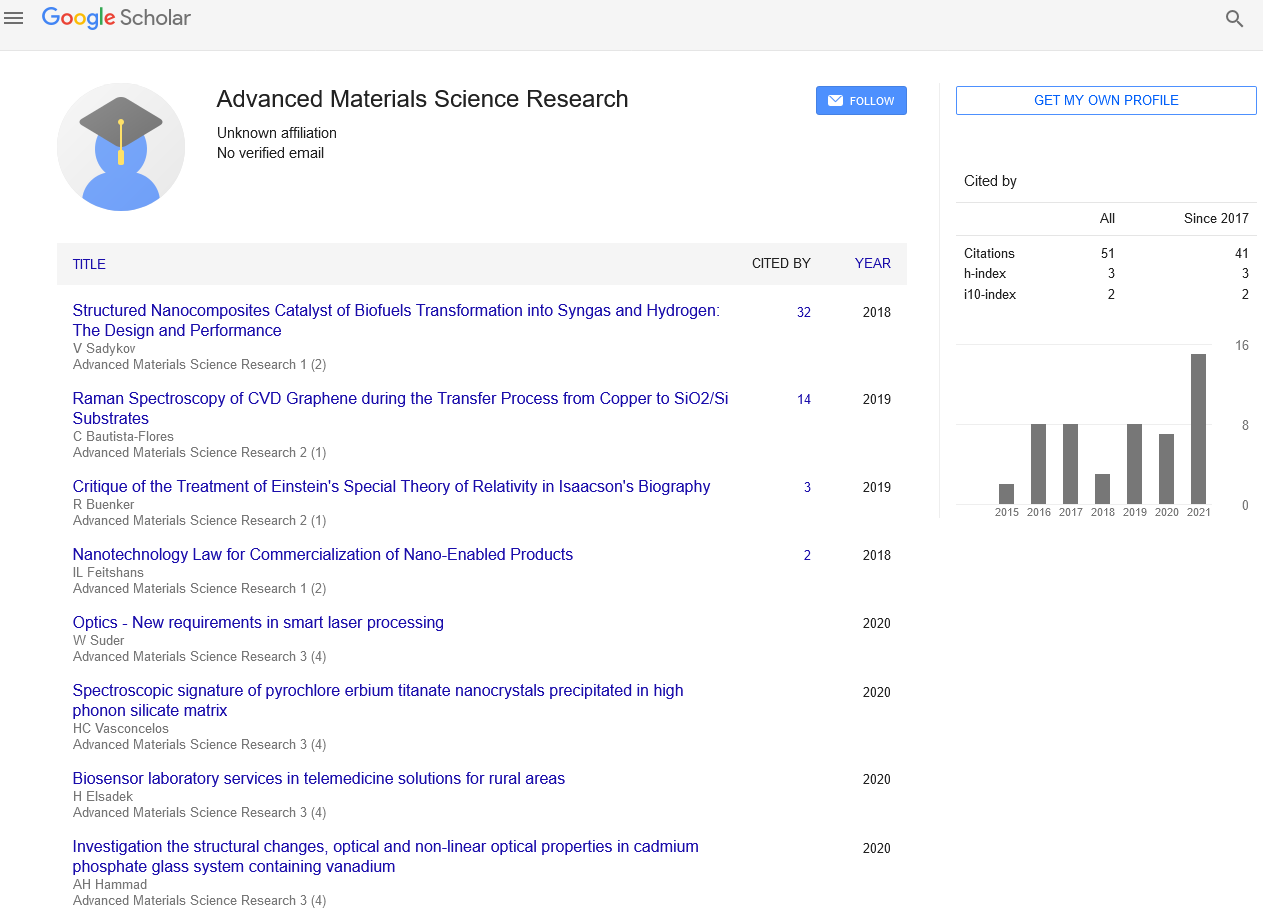Editorial - Advanced Materials Science Research (2023) Volume 6, Issue 4
The Power of Semiconductor Materials Paving the Way for Technological Advancements
Zehen Prit Singh*
Faculty of Science & Engineering, University of Groningen, Netherlands
Faculty of Science & Engineering, University of Groningen, Netherlands
E-mail: Zehensingh34@gmail.com
Received: 01-Aug-2023, Manuscript No. AAAMSR-23-108060; Editor assigned: 03-Aug-2023, Pre-QC No. AAAMSR-23-108060 (PQ); Reviewed: 17-Aug-2023, QC No. AAAMSR-23-108060; Revised: 22-Aug-2023, Manuscript No. AAAMSR-23-108060 (R); Published: 29-Aug-2023; DOI: 10.37532/ aaasmr.2023.6(4).67-69 Editorial
Abstract
Semiconductor materials play a pivotal role in modern electronics and technologies, serving as the foundation for a wide range of devices that have revolutionized the way we live, communicate, and compute. This abstract provides a concise overview of semiconductor materials, exploring their fundamental properties, applications, and recent advancements. The first section of the abstract delves into the intrinsic characteristics of semiconductor materials, highlighting their unique electronic structure, energy bandgap, and conductivity properties. Understanding these features is crucial for comprehending the behavior of electrons and holes within these materials, which in turn governs their applications in electronic devices. the wide-ranging applications of semiconductor materials. Starting with the cornerstone of semiconductor electronics, the diode and transistor, it expands into various other devices like integrated circuits (ICs), light-emitting diodes (LEDs), solar cells, and sensors. The pivotal role of semiconductors in enabling digital computing, communication systems, renewable energy conversion, and sensing technologies is underscored.In the third section, the abstract covers the latest advancements and emerging trends in semiconductor research. Topics such as nanoscale and quantum-scale semiconductor devices, two-dimensional materials like graphene and transition metal dichalcogenides (TMDs), as well as organic semiconductors and perovskite materials, are discussed. These novel materials and techniques are driving innovation in semiconductor technology and opening up new possibilities for next-generation devices.
Keywords
Semiconductor materials • Electronics • Energy bandgap • Semiconductor devices • Nanotechnology • Emerging materials
Introduction
Semiconductor materials play a pivotal role in modern technology, underpinning an array of electronic devices and applications that have become an integral part of our daily lives. These materials possess unique electrical properties that enable them to be the building blocks for countless electronic components, ranging from transistors and diodes to microprocessors and memory chips. In this article, we will explore the significance of semiconductor materials and their influence on various aspects of technology [1]. Semiconductor materials remain the bedrock of modern electronics, continuously evolving and transforming the technology landscape. As research and development efforts continue, their significance will only grow, leading to more powerful, energy-efficient, and diverse applications that shape the future of society and economy [2].
What are semiconductor materials?
Semiconductor materials are substances that lie between conductors (materials with high electrical conductivity) and insulators (materials with low electrical conductivity). They derive their name from their intermediate electrical conductivity, which can be modified by the addition of certain impurities or by altering their temperature [3].
The most common semiconductor material is silicon (Si), which has been the cornerstone of the electronics industry for decades. Other semiconductor materials include germanium (Ge), gallium arsenide (GaAs), indium phosphide (INP), and many more. Each material possesses unique characteristics that make it suitable for specific applications [4].
How do semiconductors work?
At the heart of semiconductor technology lays the concept of the "bandgap." The bandgap is the energy range in which electrons in a material can exist in either a "valence band" (low energy) or a "conduction band" (high energy). In insulators, the bandgap is significant, meaning electrons cannot easily jump from the valence band to the conduction band, thus inhibiting electric current flow. In conductors, the bandgap is virtually non-existent, allowing electrons to move freely, resulting in high electrical conductivity [5].
Semiconductor materials have a moderate bandgap, which means they can conduct electricity under specific conditions. When energy, in the form of heat or light, is applied to a semiconductor, electrons are excited and jump from the valence band to the conduction band, creating "holes" in the valence band. The movement of electrons and holes facilitates the flow of electric current, making semiconductors a vital component of electronic devices.
Applications of semiconductor materials
Semiconductor materials have revolutionized various industries, contributing to the development of countless devices and technologies, some of which include:
Integrated circuits (ICs): Integrated circuits, commonly known as microchips, are the backbone of modern electronics. These small chips are composed of thousands to billions of transistors and other semiconductor components, enabling the processing and storage of information in computers, smartphones, and other digital devices [6].
Transistors: Transistors act as switches or amplifiers in electronic circuits. Their miniaturization and efficiency have led to the creation of smaller, faster, and more powerful electronic devices.
Light emitting diodes (LEDs): LEDs are semiconductor devices that convert electrical energy directly into light. They are widely used in lighting, display panels, and indicators, offering significant energy savings compared to traditional incandescent bulbs.
Solar cells: Photovoltaic solar cells employ semiconductor materials to convert sunlight into electricity. This renewable energy technology has grown exponentially in recent years, contributing to a more sustainable future.
Optoelectronics: Semiconductor materials enable the creation of optoelectronic devices, such as laser diodes and photodetectors, which find applications in telecommunications, medical instruments, and optical data storage [7].
Challenges and future prospects
While semiconductor materials have undoubtedly shaped the modern world, their continued progress faces certain challenges. As electronic devices become smaller and more powerful, the industry must find innovative ways to overcome the physical limitations of existing materials. Researchers are exploring alternative materials, such as graphene and gallium nitride (GaN), to develop faster and more energyefficient devices [8].
Additionally, semiconductor manufacturing processes must address environmental concerns associated with the production and disposal of these materials. Efforts to optimize production methods and recycle electronic waste are crucial steps toward a sustainable future [9, 10].
Conclusion
Semiconductor materials have had an unprecedented impact on society, driving the advancement of technology across diverse industries. From integrated circuits to solar cells, these materials continue to transform the way we live and interact with the world. As researchers strive to push the boundaries of what is possible with semiconductors, we can look forward to a future filled with even more remarkable innovations and breakthroughs.
References
- Xiang Y, Jiang L, Zhou Y et al. Microplastics and environmental pollutants: Key interaction and toxicology in aquatic and soil environments. J Hazard Mater. 422, 126843(2022).
- Boe CR, Jovane F. Towards a New Model of Sustainable Production: ManuFuturing. Annals CIRP. 45,415–420(1996).
- Jovane F, Yoshikawa H, Alting L et al. the incoming global technological and industrial revolution towards competitive sustainable manufacturing.CIRP annals.57,641-659(2008).
- BuRalli J, Junquei R. Moving towards the sustainable development goals: the unleash innovation lab experience.Ambient Soc. 21, e00010 (2018).
- Chris S, Richard B, Richard B et al. Sustainable development in a post-Brundtland world.Ecol Econ. 57, 253-268(2006).
- Rosen M A. Sustainable development: A vital quest.Eur J Sustain Dev Res.1, 2542-4742(2017).
- Winters LA, Yusuf S. Dancing with Giants: China, India and the Global Economy. 35–66(2007).
- Bakir A, Rowland SJ, Thompson RC. Transport of persistent organic pollutants by microplastics in estuarine conditions. Estuar Coast Shelf Sci .140, 14–21(2014).
- Hidayaturrahman H, Lee TG. A study on characteristics of microplastic in wastewater of South Korea: Identification, quantification, and fate of microplastics during treatment process. Mar Pollut Bull. 146, 696–702(2019).
- Ziheng L. Computational discovery of energy materials in the era of big data and machine learning: a critical review. Materials Reports Energy.1, 100047(2021).
Indexed at, Google Scholar, Crossref
Indexed at, Google Scholar, Crossref
Indexed at, Google Scholar, Crossref
Indexed at, Google Scholar, Crossref
Indexed at, Google Scholar, Crossref
Indexed at, Google Scholar, Crossref
Indexed at, Google Scholar, Crossref

